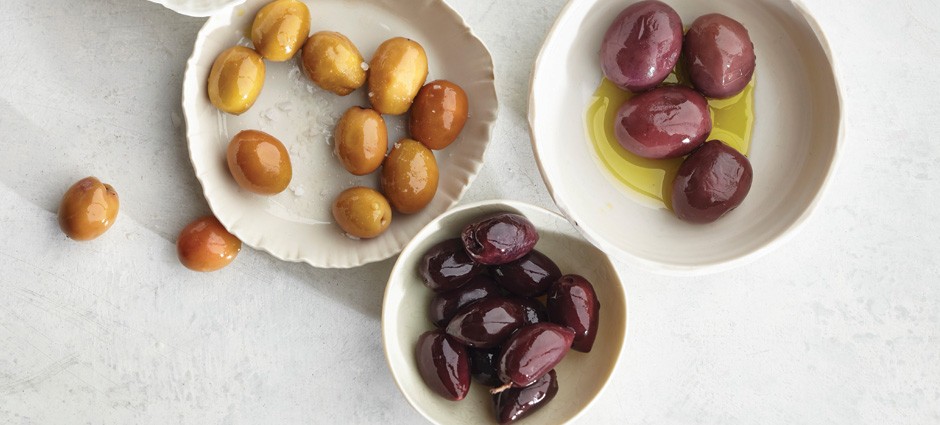“The olive tree is surely the richest gift of Heaven,” declared Thomas Jefferson, our nation’s third president. For thousands of years, people have shared this sentiment, appreciating the tree certainly for its shade, wood and leaves, but primarily for its decadent oil and edible fruit. To suit our modern tastes, however, olives must be cured before consumption to reduce their bitterness (for more on this process, see “Find a Cure”).
Many Americans reduce olives to two simple categories—green and black—but the reality is much more complex. In fact, green and black aren’t two different types of olives; the colors indicate where the olives are in their ripening process. They are green early on, deepening into brown, and then red or purple, and finally into deep-purple or black hues.
Hundreds of olive cultivars exist, but here we examine some of the most popular at your local store.
- Castelvetrano: Hailing from Sicily, this green olive variety tends to be crisp and mild, making it ideal to pair with cheese and wine for an appetizer. Tip: Natural Castelvetrano olives are pale to apple green; if they’re too bright, they may have been dyed.
- Greek: Greek olives are not a single type of olive; rather, it’s a catch-all name for any olive grown in Greece, the most popular of which is Kalamata (read on). Most often, you’ll find jars with a sampling of both green and black Greek varieties packaged together.
- Kalamata: This purple, meaty olive is named after a city in southern Greece and is a staple of Greek cuisine. It’s typically processed in red wine vinegar or olive oil and has a strong, slightly bitter flavor that complements pizza and pastas, and makes for a tasty tapenade to spread on bread.
- Manzanilla: When you think of a stuffed green olive, you’re most likely picturing a Manzanilla, which is also a classic martini olive. It’s originally from Spain but is also produced in California, and its bitter, almost-smoky taste means it’s well-suited to breads, chicken and, of course, Bond’s drink of choice.
- Mission: Olives are not native to the Americas, but early missionaries in California developed this cultivar. The green fruit has a mildly nutty flavor, but it is most often picked while green, cured and then oxidized, which turns it into the familiar canned “black” olive so common on pizza and in Mexican dishes.
- Queen: This variety is like Manzanilla olives’ big sister. It can refer to a number of Spanish cultivars, all of which produce a large green olive with a long pit and briny taste. Like Manzanillas, queen olives are often stuffed with pimento or garlic, or used in martinis.
Did you know?
- Olive trees are rarely grown from seeds, because that can lead to small yields. Instead, branches or roots are cut from existing trees and planted deep in the ground or grafted into existing trees.
Find a Cure
- Olives contain phenols—most prominently one called oleuropein—that make them too bitter to eat until they’re cured, a process similar to fermentation. Producers use a variety of curing techniques, but the most common is to soak the olives in lye. This is by far the fastest method, which is why producers use it, but it can also zap some of the flavor. If you’re willing to pay more, you may find fuller flavor in olives cured in brine, water, salt or even on the vine, as with the wrinkled Greek olive known as Thrubolea.
Does your store have an olive bar?
- Find even more varieties, like Nicoise (for nibbling or in salads), Picholine (crisp and crunchy) and Cerignola (often stuffed with garlic or cheese).
Click here for a lemony herby pasta with olives recipe.

